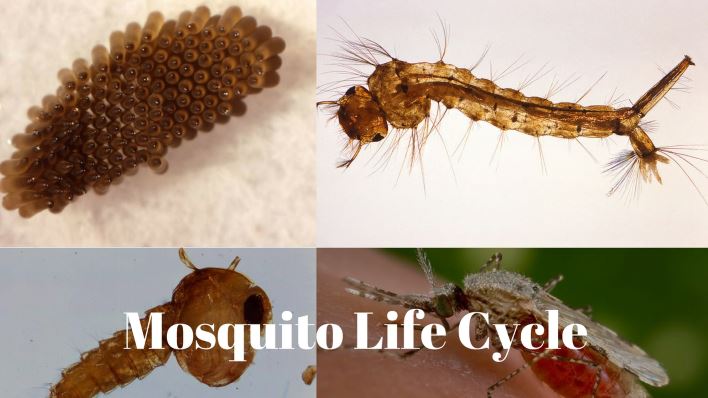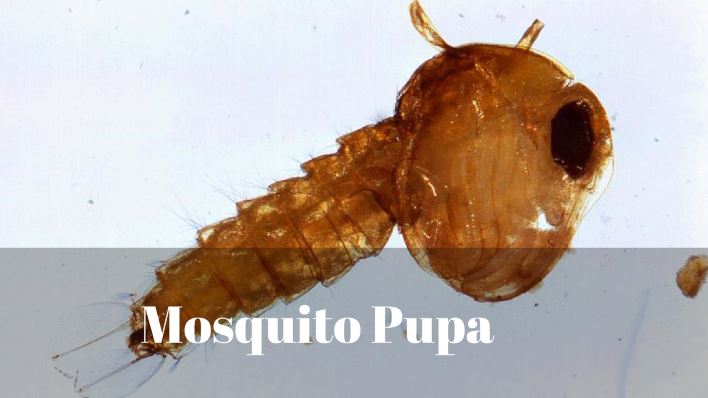Like all insects with a complete life cycle (HOLOMETABOLA), the mosquito life cycle has 4 stages: egg, larvae, pupae and finally the flying (and biting) adult.


This mosquito life cycle stage starts for some species as a single egg on the water surface (e.g. Anopheles), single egg at the water pond edges (e.g. Aedes) or a group of eggs on the water surface, known as egg rafts (e.g. Culex). Normally under optimal conditions, the eggs will hatch after two days. Some mosquitoes (e.g. Aedes) have aestivation eggs, which can stay dormant if conditions are not right (drying pond, low temperatures) and hatch in the next appropriate (e.g. rainy) season.

Most species have a siphon at their abdominal edge with which they cling into the water surface tension as they breathe. Species of Anopheles do not have this siphon and attach the surface with all their body length. Species of Mansonia have saw-like teeth in the siphon edge. They cut and stick the siphon into water plant to steall their oxygen!

Being fed and mated the mosquito female will look for a host to blood-feed during its adult mosquito life cycle. Few mosquito species do not bite at all and thus oviposit only a small number of eggs. The mosquito finds the right host by the typical concentration of CO2 around its body, body temperature and other typical odors.
Some species will look after a wide range of hosts during their adult mosquito life cycle, while other will have more specific attraction. Some will prefer mammals, some will look for birds and some will even specialize on biting reptiles or amphibians. Normally, two days after biting the mosquito will oviposit and starts the mosquito life cycle all over again…

Mosquito Life Cycle - 1
The first stage in the mosquito life cycle is the egg. Under optimal conditions, normally two days after being blood fed – the mosquito female finds water source for oviposition (laying eggs in insects). Mosquito females have complex set of attractants and repellents when they are selecting a site to oviposit. Water salinity, acidity, and temperature affect the oviposition site selection as well as the presence of mosquito larval food and larva predators.
This mosquito life cycle stage starts for some species as a single egg on the water surface (e.g. Anopheles), single egg at the water pond edges (e.g. Aedes) or a group of eggs on the water surface, known as egg rafts (e.g. Culex). Normally under optimal conditions, the eggs will hatch after two days. Some mosquitoes (e.g. Aedes) have aestivation eggs, which can stay dormant if conditions are not right (drying pond, low temperatures) and hatch in the next appropriate (e.g. rainy) season.
Mosquito Life Cycle - 2
The second stage of mosquito life cycle is the larvae. Mosquito larvae have long and narrow body which fits for life in the water. Some filters micro-organisms and other organic matter from the water column, other scrape algae on pond edges and few are predators. Like in all mosquito life stages, the mosquito at its larvae phase breathe atmospheric oxygen and has to swim up to the surface for that.
Most species have a siphon at their abdominal edge with which they cling into the water surface tension as they breathe. Species of Anopheles do not have this siphon and attach the surface with all their body length. Species of Mansonia have saw-like teeth in the siphon edge. They cut and stick the siphon into water plant to steall their oxygen!
Mosquito Life Cycle - 3
The third stage of the mosquito is the pupae. Mosquito pupae would normally float immobile just below the water surface. However, they are capable to dive or swim aside in a case of danger. This phase in the mosquito life cycle last usually 2-3 days, after which the adult emerges.
Mosquito Life Cycle - 4
The last stage of the life cycle is the adult. On the first day after emergence the adults feed on sugar from sources like nectar or fruits. During this day they can mate and the males will die shortly after mating. Females, however, may live for few weeks and that first mating provide them with enough sperm to last throughout their lifetime.Being fed and mated the mosquito female will look for a host to blood-feed during its adult mosquito life cycle. Few mosquito species do not bite at all and thus oviposit only a small number of eggs. The mosquito finds the right host by the typical concentration of CO2 around its body, body temperature and other typical odors.
Some species will look after a wide range of hosts during their adult mosquito life cycle, while other will have more specific attraction. Some will prefer mammals, some will look for birds and some will even specialize on biting reptiles or amphibians. Normally, two days after biting the mosquito will oviposit and starts the mosquito life cycle all over again…
Mosquito Life Cycle
4/
5
murat
